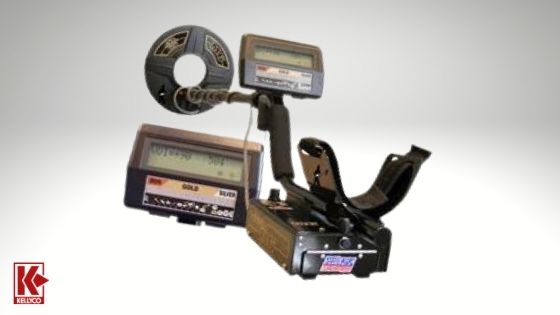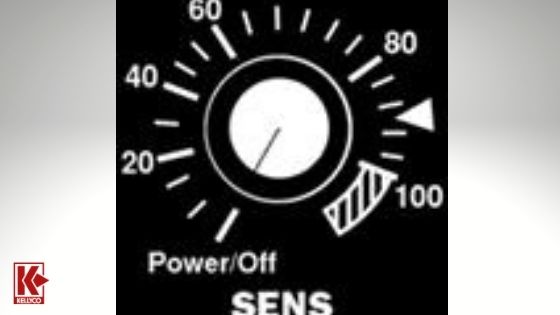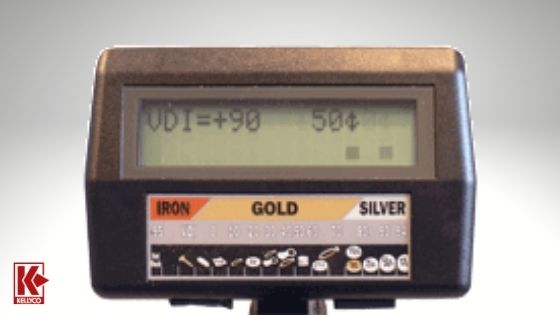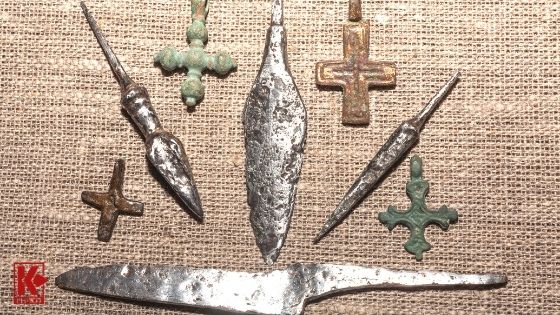Field Test: White’s Matrix M6 Metal Detector Review
Published by Jenna Anderson on 08/06/19
Reprinted with permission from Western & Eastern Treasures
From page 43 of the March 2007 issue of Western & Eastern magazine.
By Ben Myers

White’s M6
The numbers on the display screen of the White’s M6 were reading +83 Target ID at a depth of 9″. The signal was under overhanging bushes near the center of a park. Since the area dated back to the mid 1880’s, with a nearby military establishment, an old silver coin definitely came to mind. Although well hunted by detectorist over the last 30 years, the location still produces a pleasant surprise now and then.
Pealing back a plug of grass, I carefully placed the deeper soil onto a small drop cloth for neater digging. The White’s M6 had located a highly sought smaller variety of an antique military button. However, since I had thought, “Silver Coin,” the button was not immediately noticed when I began poking through the soil pile. A pass of the coil over the dirt resulted in a VDI (Visual Discrimination Indicator) reading of +43. When I saw the small brass button, the change in target ID numbers initially gave me concern. Upon consideration, though, concern gave way to admiration. That button had been buried for over 75 years.
Due to halo effect (metal leaching into the surrounding soil to make the target look larger), the White’s M6 had been right on target in its analysis. In Fact, it was impressive to get a high ID number on such a deep, small target. I was now confident that the White’s M6 could be depended upon to locate deep &/or small silver coins and relics.
Features & Design
In producing the White’s M6 Matrix Series metal detector, White’s Electronics brings a new simplicity to finding treasure. Four controls make it a pleasure to use, a trigger switch on the handle, plus tow rotary knobs and a 3-position AutoTrac toggle on the box. Operation is effortless in the extreme, yet the features of this deep seeking detector include a full size digital display screen, VDI target ID numbers from -95 to +94, 3-lvel visual block system for separate source target ID information, target labels, traditional audio or 7-zone Target Tone ID, visual indicator Pinpoint and depth reading, Sensitivity and Discrimination Controls, and 3- position automatic ground balance with auto tracking. White’s had packed a profusion of abilities into a lightweight metal detector that’s easy to understand and use.

Full Size Digital Display Screen
The White’s M6 possesses an S-handled type arrangement, with the control box under the elbow rest for precise balance. The padded elbow rest can be adjusted forward or backward to match arm length. My only complaint about the design is the manner in which the cable extends from rod to the connector on the box. Although it’s not a big deal, it is more desirable to have the coil cable run below (not alongside) the handgrip, as on the DFX and MXT. The White’s M6 is standard equipped with a 9.5″ Eclipse search coil that is interchangeable with all Eclipse accessory coils. The rod provides a solid, wobble free sing using stainless steel spring clips and adjustable cam locks. The control box contains an external speaker, stereo headphone jack, and battery compartment. Painted on the bottom of the box is a short list of “Quick Start” instructions for reference in the field if needed. The White’s M6 is American crafted in Sweet Home, Oregon, and boasts an aircraft grade aluminum housing.
The sensitivity rotary knob turns the machine On/Off, in addition to adjusting the sensitivity level. Numbers around the knob run to 100, plus an extra-sensitive area at Max, The preset mark is an initial position. Raise or lower sensitivity according to hunting condition. The optimal setting is as high as possible without causing the detector to become unstable (False signals). The White’s M6 has an LCD warning and audible squawk to warn that sensitivity is too high for the soil mineralization. The display reads “OVERLOAD – REDUCE SENS/LIFT LOOP.” The message could also mean that the coil had gone over a very large or shallow target, making proper ID difficult. In that case, try raising the coil a bit and sweep again.

Discrimination (DISC) Control
Discrimination (DISC) Control is the other rotary knob on the control box. It is used to eliminate audio responses from unwanted targets. Basically, target identify themselves by how well they conduct electricity. As with all metal detectors, high discrimination can lose some good targets along with bad ones. For example, a gold ring or valuable token can shore the equivalent conductivity (VDI#) of a pulltab. Gold can appear just about anywhere on the conductivity scale, mostly due to size, shape and alloys used. Thankfully, most U.S. coins register in the higher numbers. Discrimination level depends upon how many pulltabs you are willing to dig for the possibility of that one gold ring. 100? 1,000? Every hunting situation is different, with varying amounts of trash. Fortunately, the White’s M6 provides a choice with a turn of the DISC knob.
As the control rotates clockwise, it audibly eliminates more metal targets according to their conductivity. There are two preset marks, with #1 recommended for most hunting. It is set to accept nickels and many gold rings while eliminating iron and tin foil. Preset Mark #2 raises the discrimination level to eliminate most pulltabs and everything below it. Take note that a discriminated item will have a slipped sound or not give an audible beep , yet the visual target ID number will always appear in the screen.
TRIGGER CONTROL is the toggle on the handle beneath the LCD pod. The forefinger reaches it easily. It has three position: Squeeze and hold for pinpoint, center position for one-tone discrimination, and forward locked for the 7-tone ID by pushing the trigger toggle into the forward position. With DISC control set low, all seven pitches are heard. The audio frequency of tone ID is not to be confused with the operating frequency of the White’s M6 (14kHz). Each of the seven pitches matches a corresponding category of VDI numbers. The lower the tone, the lower the VDI number. the tones run from a VDI of (minus) -95 (57Hz low tone) through all seven tones into VDI +70 to +95 (900Hz, highest tone). With the trigger in the center position, you will hear the traditional, one-tone beep.
Visual Target ID displays for both 7-Tone ID and Traditional Disc. Depending upon the setting of the DISC control, signals will generally produce smooth, solid beeps fro accepted target and no beep or only a broken sound for targets set to be discriminated. PINPOINTING (squeeze and hold) also activates the depth reading in the LCD screen. After sweeping the coil over an interesting target, keep your eyes on the spot while sweeping from the 90 degree angles to the X the spot. Then squeeze and hold the trigger to switch a non-motion, All-Metal mode, bringing the coil over the object. When the signal is the loudest and the signal strength indicator is full, the center of the coil is over the center of the target.
The TRAC TOGGLE switch on the control box takes away the worry for those who dread ground balancing. This ingenious system from White’s provides three choices – beach, Lock Off, and Auto Trac On. In most ground situations, just set the toggle to Auto Trac (On position). Select your choice for regular or Tone ID on the Trigger Switch, and set the discrimination level. Turn the detector ON with the Sensitivity Knob while setting the Sensitivity level. Find a small piece of ground containing no interfering metal. Lower the coil to the ground, then pump it up and down a couple of times about 2-4″. AutoTrac now has the detector automatically set to handle mineralization and will continue tracking to keep it ground balanced. If false signals (Beep but no target) occur while hunting, excessive sensitivity is the most likely cause. Another problem is ground infested with decomposing rusty pieces of iron or some other unusual ground condition. If the detector is acting up only when the coil is in motion, try the Lock off position. Auto Trac is trying to track and reset to the unstable ground. In this case, find a clean area, pump the coil as before, then move the toggle to Lock. In this way, the detector will monitor but not readjust to changing soil conditions and thus allow smoother operation. Another use for the Lock is in handling an annoying type of “hot” ( or “cold) rock. Do the balancing routine over one of the rocks, then move the toggle into the Lock position to remove the ground response of the rock. Erratic detector behavior from difficult ground is not something most people will encounter. However, the White’s M6 provides the tools to handle these situations.

When Using The White’s M6 On Wet Salt Sand, Flip The Toggle To “Beach”
The third position is “Beach.” Most detectors work well on dry sand. However, saltwater or desert alkali conditions can drive a detector nuts with false signals. When using the White’s M6 on wet salt sand or black sand, you can flip that toggle to “beach.: Do not forget to re-balance on wet sand in the “Beach” mode kept operation smooth.
The White’s M6 uses eight “AA” batteries inside a holder, which slides into the rear of the control box behind a latched door. The either batteries provide about 40 hours of hunting. Rechargeable’s can be used to about 30-35 hours. Kellyco sells these batters as (#802-5211) and the charger as (#509-0022). As with all detectors, using headphones will extend the life of batteries. Be sure to use headphones with a volume control, as the M6 does not have one. Watch the display screen when the detector is turned on for battery life. It starts at 12 volts and over time will deplete to about 8 volts or less. When the “Lo Bat” warning appears on the screen, replace the batteries.
The DISPLAY SCREEN or LCD sits in the po at the top of the handle and is large enough so that there is no difficulty in reading it. Just below it is a reference label with corresponding information for iron, gold and silver ranges. VDI numbers and target icons. The Display has an abundance of information to help the user gain knowledge of the target. In fact, there are five helpful indications: VDI number, Blocks, Labels, Depth Indication, and Pinpoint Blocks.
The VDI refers to the number assigned to the target by how well it conducts electricity. The numbers rage from mine (-)95 up to plus (+) 94. New detectorists will quickly learn that many targets (including US coins); produce consistent Target ID (VDI) numbers.
LABELS are words or coin references that appear on the right, top tide of the screen. Examples are Ring, 10 Cents, Iron, 25 Cents, etc. These are the most common target groupings in the identity range. If two are listed, the first is the most likely.
BLOCKS are darkened cursors that appear at the bottoms of the display and line up with icons shown in the reference label below it. They come from a separate source than the VDI number and therefore offer a second target analysis. A fully darkened block means that the White’s M6 is very sure of the target information, a half block means that partial information has been gathered and a quarter block means that partial information has been gathered, and a quarter block indicates only a small portion of information.
Depth indication of target displays up to 12″ when the trigger is squeezed and held. Keep in mind that is is calibrated for coin-sized objects.
PP BLOCKS are darkened blocks below the depth reading when the trigger is squeezed and held for Pinpointing. The more blocks that are seen, the stronger the signal.
Field Trips

Field Trip
Remember that old military button mentioned at the beginning of this article? That was on the first trip, and the M^ was off to a stellar start. The button was deep, and the bush roots I had to cut through were difficult, but it was worth it. However, everything else turning up was modern, due to relentless detecting by many people over the years. Even so, the White’s M6 provided me with two Barber dimes at about 5″. How was this achieved? The White’s M6 has a wealth of accessory coils available. Hunting near the sidewalk that surrounds the park is difficult. The metal bars inside it overload detector coils that come too close. So, it was time to switch to the Eclipse 4″x6″ Shooter DD coil.
This little coil is outstanding in trashy areas, fitting into tight spots and still providing great depth. A Double D coil provides a matrix that runs along the center of the coil and straight down into the ground. Some have described it as a “Windshield Wiper” blade. In any case, it allowed closer hunting to that metal barred cement to pick out those two silver dimes. This coil has excellent sensitivity on tiny targets. During testing, it was used to hunt near metal playground equipment and fences. You would be surprised at what larger coils miss in these areas. If your budget allows this extra coil, I would definitely recommend it.
I would like to get back to that same park with another coil from an MXT, the DD 1400 8×14″ Deep Scan. It is a good bet that combining the White’s M6 with that deep seeking coil could provide more oldies but goodies out in the open areas. Both of the coils mentioned handle difficult mineralized ground well, and that is a plus to any search coil arsenal. White’s offers a number of other coils for the White’s M6 as well. This isn’t an ad for White’s coils; I’m just saying that the variety of coils available for the White’s M6 makes a real difference in versatility and easier hunting.
My next trip was to a saltwater beach in New Jersey. While these beaches are generally lighter in mineralization, they do have stretches with black sand. The White’s M6 worked very well in all areas. I used the 9.5″ concentric coil, plus the 8 x14″ DD. Both coils preformed flawlessly. The quiet operation of the White’s M6 in saltwater environment was amazing, and yet deep targets were found. Starting on the dry sand, I kept the discrimination extremely low, down into the iron range; sensitivity high, between preset 90 and 100; Auto Trac in the ON position, and Trigger centered for traditional beep. Ground Balancing was easy and took only a few seconds.
Later, hunting into the shallow surf itself, it was necessary to switch to “Beach” mode while remembering to ground balance again. Coins and other items were hitting well at 8″ and deeper, including two junk rings. Target ID was accurate even in these harsh saltwater surrounds. Where discrimination could be kept low, the 7-Tone mode identified iron and other items with correct tone pitches. The only good jewelry to show up was a little 14k gold earring in the surf. The M6 passed its saltwater tests while running quiet and smooth over the entire beach. It found tiny targets, including small gold, and provided good depth.

Great Finds
Several inland trips were made to parks, yards and ball fields. Some places were very trashy, some had difficult ground and some were clean from both trash and pesky ground. At a competition hunt, there was b it of interference from a couple of other Whites machines. Lowering sensitivity took care of that, since targets were not deep. The quick recovery speed between targets resulted in many great finds. Discrimination settings at hunting locations were usually kept as low as possible, at the firs preset mark or lower. In one place that I call Pulltab Park, I did not have to resort to raising the discrimination to preset mark 2 in order to avoid them.
Sensitivity in most locations could be kept at high levels without chatter. Auto Trac was always in the ON position except for a park loaded with decomposing iron. The manual’s instructions are to ground balance in a clean area, and then switch the toggle to LOCK OFF. It did work and some amazing finds were made, among them two toy guns and numerous coins in and around iron. In fact, in other areas with Auto Trac ON, the White’s M6 was able to make some good target finds near iron and junk.
In red, difficult soil, a jumpy signal +85 and +77 depth reading 5″ proved to be a 1970’s copper Memorial cent on edge at 7″. Quarters were easily found at any depth, with hard hits. One weird, hard hit with a broken sound ID#57 was a rusty washer at 4″. An overload and broken signal was a huge piece of iron. At #1 Disc setting, iron was giving negative numbers and broken audio, while a solid signal +74 was part of an aluminum can. However, Pinpoint showed it was not a coin. A +32 pulltab reading turned out to be an 8″ long piece of aluminum, a bouncy signal +22 +47 +50 was a screwcap, a consistent +35 was indeed a pulltab as shown, +28 to +32 was a pulltab with no tail and at a playground #10 ID was foil with correct depth. A bouncy +52 +75 +77 reading that pinpointed off center was a junk piece of corroded bullet casing, aluminum tops of tennis ball cans were all overload signals near the surface, a bouncy 14 to 18 was the top of a pencil, and +2- at 2″ was a nickel. A -52 from one direction, +67 & +78 was a clad dime. When that was removed, there was still a -38 signal in the same hole, a rusty iron washer. Good with iron again, gold colored aluminum ring surrounded by three pieces of iron, gave a high tone and penny reading.
From these and other date, it became apparent that a jumping around target ID (especially with an off-center pinpoint location) usually means junk targets. Shallow pulltabs sounded better than those a bit deeper, which had a slightly broken sound. After digging so many hump-around signals between +26 to +32 that were pulltabs, I started to believe the White’s M6 and passed by those signals. One interesting signal was a long one in a gully on the side of a hill, with missed VDI’s of +85 and +32. Lying there in prefect line, one after the other, were three quarters, two fishing sinkers and a pulltab with an earthwork through the center ring (the critter was returned to the hole). Another signal proved a +83 from one direction and +78 from the other. A quarter and a small belt buckle were in the same hole.

Copper Treasure
As you can see, the ID was very good with mixed targets in same proximity. The 7-tone audio mode does work well for those who like added audio information and less glancing a the LCD. It can be a bit noisy in trashy areas, though, where I preferred the single traditional tone. You will notice that the higher conductive targets have only two of the seven tones. However, that is as it should be. A serious searcher cannot afford to pass up targets that could be copper or silver anyway. Depth readings were very accurate, even for non0coin items. Pinpoint was spot on, and I could detune for even sharper pinpointing. VDI numbers were generally correct except when other targets nearby got into the mix, and that is desirable.
Bottle caps, pull tabs, and other junk tend to bound the VDI numbers around, and that is a tip off to trash. Of course, any good sounding, deep targets should be dug regardless of the VDI reading. Discrimination was very good. A number of times I would have the control set very low to pick up pieces of ron, perhaps at minus 34 ID. Then I slowly raised the discrimination halfway to the first preset mark, where the junk signal just disappeared. The White’s M6 ran comfortably quiet. The sweep speed was not a consideration, and it was possible to use a nice, slow seep even in excessively trashy ground.
Summary
As you have read, there were many good things to say about White’s M6 metal detector. Negatives bordered on non-existent, and I was looking for them. It is a good general-purpose detector for coin and jewelry hunting, yet could cross over into nugget and relic hunting as well. It is lightweight and well balanced for minimum fatigue. The cornucopia of coils available to the White’s M6 is a real plus. Although controls are straightforward and easy to use, they proved top-level operation and abilities. Especially likable points are the Auto Trac that not only ground balances the detector but tracks changes and keeps it balanced, a Beach setting to handle saltwater of desert alkali locations, good depth, quiet and smooth performance with higher sensitivity levels, sharp pinpointing, and performance that matches that of more expensive machines. I feel confident in recommending this metal detector for your consideration.
